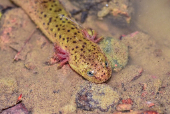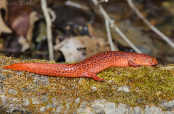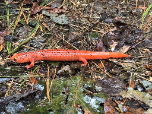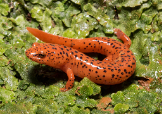Red Salamander (Pseudotriton ruber)
Description: Pseudotriton ruber is a medium/large salamander, with adults ranging from 4.3 to 7.1 inches in total length. Its sides and back vary in color from an orange-brownish tint to a bright red depending on its age. Like other salamanders, the red salamander seems to lose its color as it ages, becoming more darkly pigmented with less obscure patterns. The larvae of this species have a stout head and body, dark in coloration, lack spots, and tend to have distinct mottling or streaks.Another distinguishing characteristic of P. ruber is the appearance of numerous irregular black spots down its back. Although the red salamander is brilliantly colored and has many distinguishing features, it is sometimes difficult to tell species apart. P. ruber is most similar in appearance to the mud salamander (P. montanus), but can be distinguished by the difference in size and number of spots running down the dorsum and also by the difference in the color of the iris. Both P. ruber and P. montanus have bright red colorations that have been considered examples of a Mullerian mimetic complex. The red salamander has more spots and the spots also tend to be larger in size than those of the mud salamander. In regard to eye color, the red salamander's iris is a gold-like tint, whereas the mud salamander's iris is brown.The gold-like tint iris for the red salamander is also distinguished by its horizontal bar that runs through the iris. Mud salamanders typically have a blunter snout than the red salamander. Also, the mud salamanders typically have a more contrasting dorsal and ventral coloration than the red salamanders that are more uniform in color.
Habitat: All subspecies of P. ruber occupy moist environments such as under moss and stones near clear water sources such as streams or springs. Red salamanders are normally not found near large streams, but instead near smaller water sources.
Range: The four subspecies of P. ruber are found across the eastern United States, occupying streams through open areas such as fields and meadows, as well as aquatic areas through forested areas and mountains. Each subspecies is similar in appearance with slight differences in size and coloration, but are found in different habitats.
The northern red salamander, P. r. ruber, is characterized as being red or reddish-orange with numerous black spots down its back. This subspecies is the most common and can be found from southern New York and Ohio to northeast Alabama, as well as the Upper Peninsula of Michigan.
Similar in appearance to the northern red salamander is the Blue Ridge red salamander, P. r. nitidus. This species differs it is slightly smaller and lacks black coloration on the tip of the tail and chin. The Blue Ridge red salamander is found in elevations to more than 5,000 fett in the southern part of the Blue Ridge Mountains of Virginia.
The blackchin red salamander, P. r. schencki, differs in appearance by having strong black coloration under its chin, as well as spotting all the way to the tip of the tail. It can also be found in elevations to more than 5,000 feet in the Blue Ridge Mountains.
The southern red salamander (P. r. vioscai) is often purplish- to salmon-colored and normally has white spots on its head. This subspecies is found from southern South Carolina to southeast Louisiana and southwest Kentucky.
Diet: Adult red salamanders, like their larvae, are generalists and tend to feed on invertebrates (such as earthworms, slugs, snails, spiders, diving beetles and other insects), as well as small amphibians, including the red-backed salamander.
Reproduction: P. ruber has a wide range in its breeding season, which is only limited by extremely cold temperatures.Adults are known to migrate from streams and bodies of water to terrestrial habitats during specific seasons each year. They will then return to aquatic streams in the late summer and early fall to begin breeding. Generally, however, adult red salamanders mate annually and engage in primitive courting activities.
Females are capable of long-term sperm storage and may not lay eggs for months after mating. Females typically lay eggs in the fall or early winter in headwater streams, and have very well-hidden nests. Based on presence of scars and hypertrophied jaws in mature males, it is suggested that male P. ruber might be involved in mate-guarding behavior. Males occasionally court other males as a means of sperm competition to get the other male to deposit spermatophores, giving them a better chance of successful mating over their competitors.
Status: Listed as Least Concern in view of its wide distribution and presumed large population.
»» Kingdom: Animalia - Animals
»» Phylum: Chordata - Chordates
»» Subphylum: Vertebrata - Vertebrates
»» Class: Amphibia - (Amphibians)
»» Order: Caudata - Salamanders
»» Family: Plethodontidae - Lungless Salamanders
»» Genus: Pseudotriton
»» Species: Pseudotriton ruber - Red Salamander
This article uses material from the Wikipedia article "Red Salamander", which is released under the Creative Commons Attribution-Share-Alike License 3.0. Content may have been omitted from the original, but no content has been changed or extended.
|













